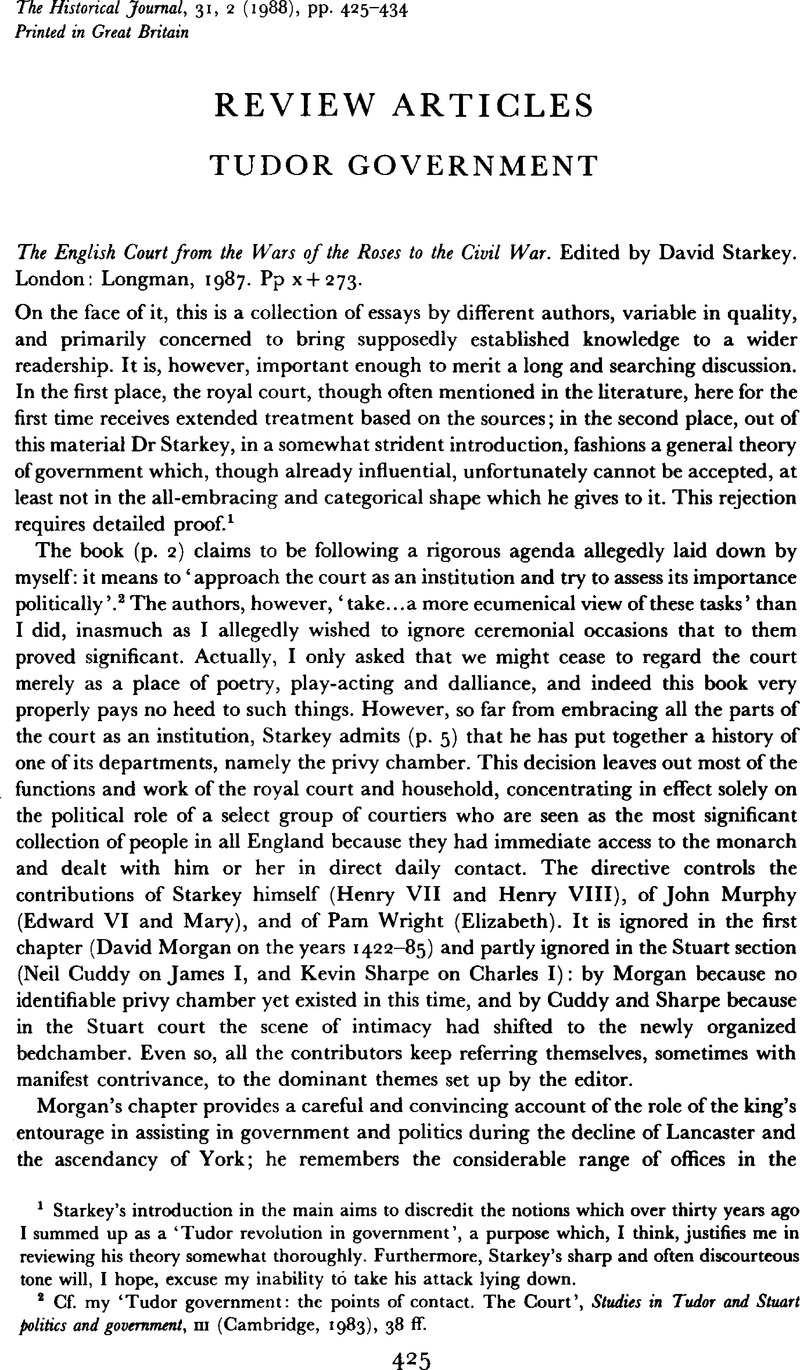Published online by Cambridge University Press: 11 February 2009

1 Starkey's introduction in the main aims to discredit the notions which over thirty years ago I summed up as a ‘Tudor revolution in government’, a purpose which, I think, justifies me in reviewing his theory somewhat thoroughly. Furthermore, Starkey's sharp and often discourteous tone will, I hope, excuse my inability to take his attack lying down.
2 Cf. my ‘Tudor government: the points of contact. The Court’, Studies in Tudor and Stuart politics and government, III (Cambridge, 1983), 38 ffGoogle Scholar.
3 Cf. my review of this misconception,Historical Journal, XXX (1987), 709–16Google Scholar.
4 Hoak, Dale E., ‘The king's privy chamber, 1547–1553’. In Tudor rule and revolution, ed. Guth, D. J. and McKenna, J. W. (Cambridge, 1982), pp. 87–108Google Scholar.
5 Adams, Simon, ‘Eliza enthroned? The court and its politics,’ In The reign of Elizabeth I, ed. Haigh, C. A. (London, 1984), pp. 55–77CrossRefGoogle Scholar.
6 Hoak, Dale E., ‘The secret history of the Tudor court: the king's coffers and the king's purse, 1542–1553,’ Journal of British Studies, XXVI (1987), 208–31CrossRefGoogle Scholar. He holds that the exceptional circumstances of the duke of Northumberland's rule produced a temporary use of privy chamber personnel for less obviously household purposes, but the money handled by Peter Osborne still looks to me very much like money spent on business personal to the king (which included certain aspects of war). In the main, the irregularities of those years reflect desperate straits, but even so all the accounts were audited in the Exchequer, something unknown in the old ‘chamber system’.
7 Starkey, D. R., ‘Representation through intimacy,’ Symbolism and sentiments, ed. Lewis, I. (London, 1977), pp. 187–224, at p. 212Google Scholar.
8 Tudor revolution in government (Cambridge, 1953), pp. 408–10Google Scholar. I there said nothing about the privy chamber, discovered much later by Starkey, but this act of 1541 shows that it too received attention at this time.
9 Cf. the summary in L[etters and] P[apers of Henry VIII], XVIII, ii, 231.
10 Tudor revolution in government, p. 282.
11 The list is printed in my Tudor constitution (2nd edn, Cambridge, 1982), pp. 96–7Google Scholar.
12 LP, XIII, i, 1: the list belongs to 1537, not 1538. I do not wish here to re-argue the case for the institutionalizing of the privy council in 1536, clearly demonstrated by such a list as this and the sudden appearance of councillors called ‘ordinary’ or ‘at large’; that case is set out in Tudor revolution, 339–40. The question whether Cromwell established it or it was the product of a political crisis (Guy, J. A., ‘The privy council: Revolution or evolution?’, Revolution reassessed, ed. Starkey, D. and Coleman, C. [Oxford, 1983], pp. 59–85Google Scholar) is of no concern here.
13 LP, XXI, ii, 634/1.
14 See Symbols and sentiments, p. 212.
15 Acts of the privy council, ed. Dasent, J., II, 62, 107, 237, 262, 405Google Scholar.
16 Hoak, , in Tudor rule and revolution, pp. 100–3Google Scholar.
17 31 Henry VIII, c. 8 (the list names holders of offices, none of them in the privy chamber); LP, XV, 5.
18 Hoak, D. E., The king's council in the reign of Edward VI (Cambridge, 1976), p. 9Google Scholar.
19 Colvin, H. M., ed., The history of the king's works, IV/(2) (1982), 301, 309Google Scholar; Acts of the privy council, XI, 63, et post.